This summer (26 July through 2 August) I had the pleasure to serve as a guest geologist on a rafting trip to the Grand Canyon. The trip logistics were engineered by Doug Drushal under the auspices of Environmental Experiences, Inc. These trips were begun by former Wooster Geology Professor, Dr. Frederick W. Cropp III in 1980. Doug and Fred’s son Tom Cropp have continued to provide the organization and logistics for these exciting and geologically enlightening rafting trips. Special thanks to JP, our boatman, and Phil (swamper) of Hatch River Expeditions for sharing their knowledge and extensive experience of the history and geology of the Canyon.
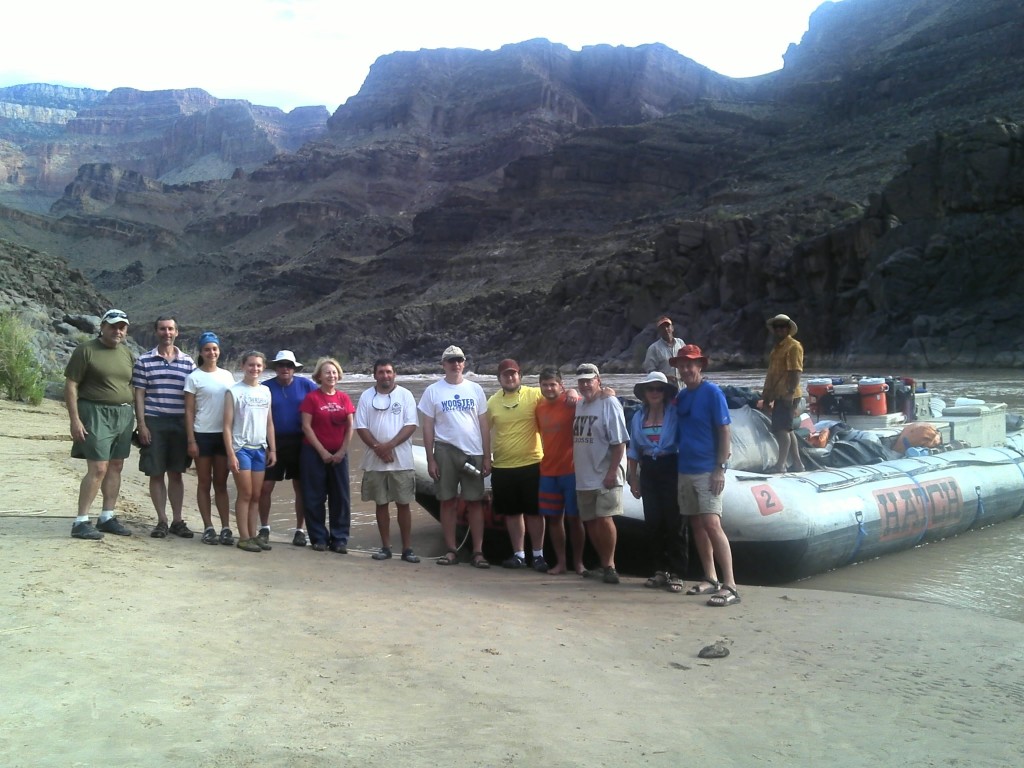
The group poses in front of the Great Angular Unconformity. Note the tilted Precambrian Supergroup underlying the Cambrian section consisting of Tapeats Sandstone and Bright Angel Shale (see the stratigraphic section here to remind yourself of the stratigraphy). On the boat is the boatman JP and swamper Phil.
Some of the geological highlights are explained in the captions below. Not only were we treated to classic geology, but we also were able to experience and view some of the power of water in the canyon – flash floods and debris flows.

The reverse exfoliation in the Permian Esplanade Sandstone is one the the best examples of its kind. Usually when we discuss exfoliation we think of domes. The homogeneous nature of the stone along with the local stresses and erosion by the stream combine to give this unnamed side valley of the Grand Canyon such a unique (and highly photographed) look.
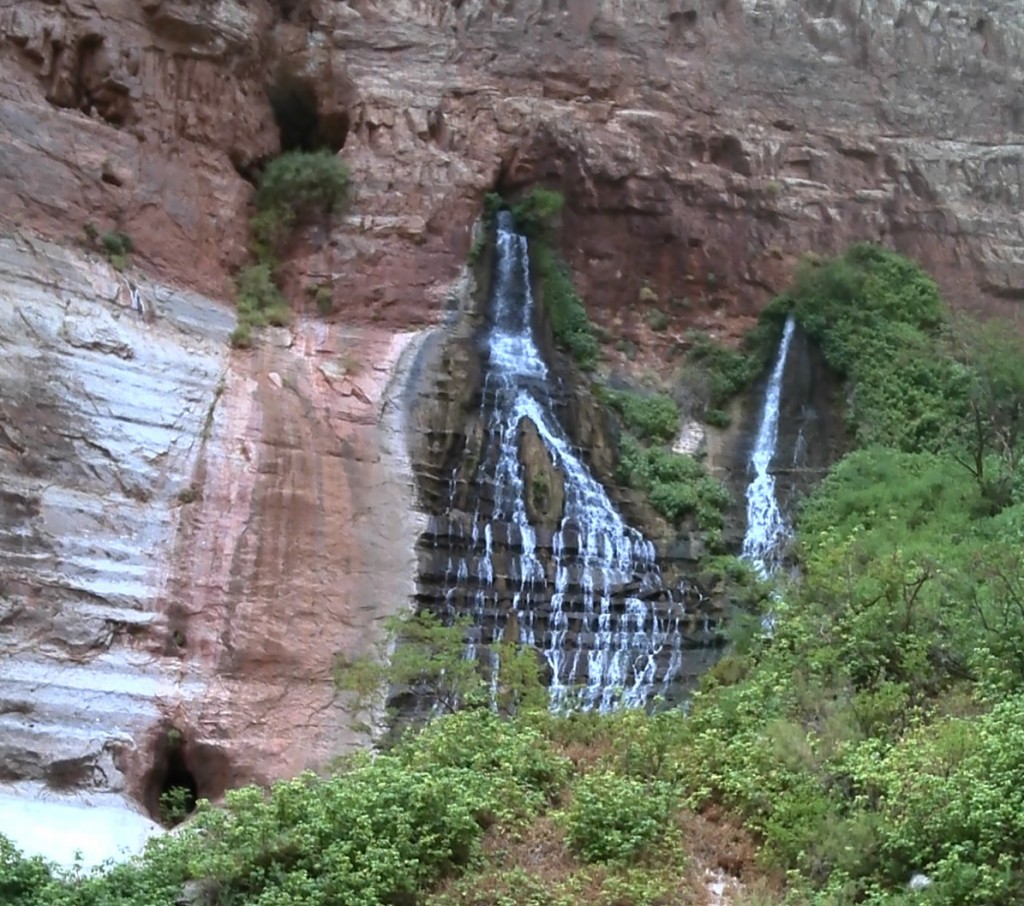
Springs emanating from the fractures and karst in the Redwall-Muav Limestone Aquifer provide an oasis in the Canyon and a needed water source for travelers.
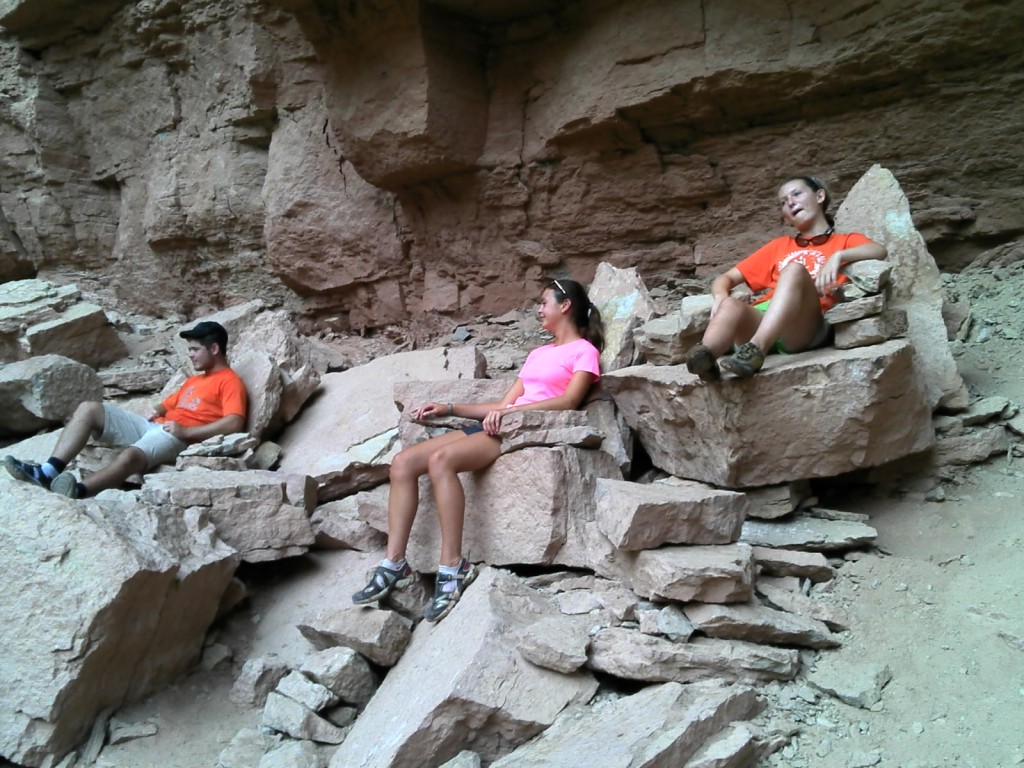
Some of the group reclines on chairs in the Throne Room at Dutton Spring in the Redwall Limestone. Clarence Dutton (born in Wallingford, CT) published one of the earliest geologic studies of the canyon in 1882.
 An inside-out waterfall (JP’s term). Note the encased waterfall of travertine. Three physical effects can lead to travertine deposition at waterfall sites: aeration, jet-flow, and low-pressure effects. The three physical effects are induced by two basic changes in the water: an accelerated flow velocity, and enlargement of the air-water interface area. These two changes increase the rate of CO2 outgassing so that a high degree of supersaturation of calcite (travertine) is reached, which then induces travertine precipitation. Note also the four intrepid explorers who facilitated the older folks into getting more involved with the water holes and falls.
An inside-out waterfall (JP’s term). Note the encased waterfall of travertine. Three physical effects can lead to travertine deposition at waterfall sites: aeration, jet-flow, and low-pressure effects. The three physical effects are induced by two basic changes in the water: an accelerated flow velocity, and enlargement of the air-water interface area. These two changes increase the rate of CO2 outgassing so that a high degree of supersaturation of calcite (travertine) is reached, which then induces travertine precipitation. Note also the four intrepid explorers who facilitated the older folks into getting more involved with the water holes and falls.
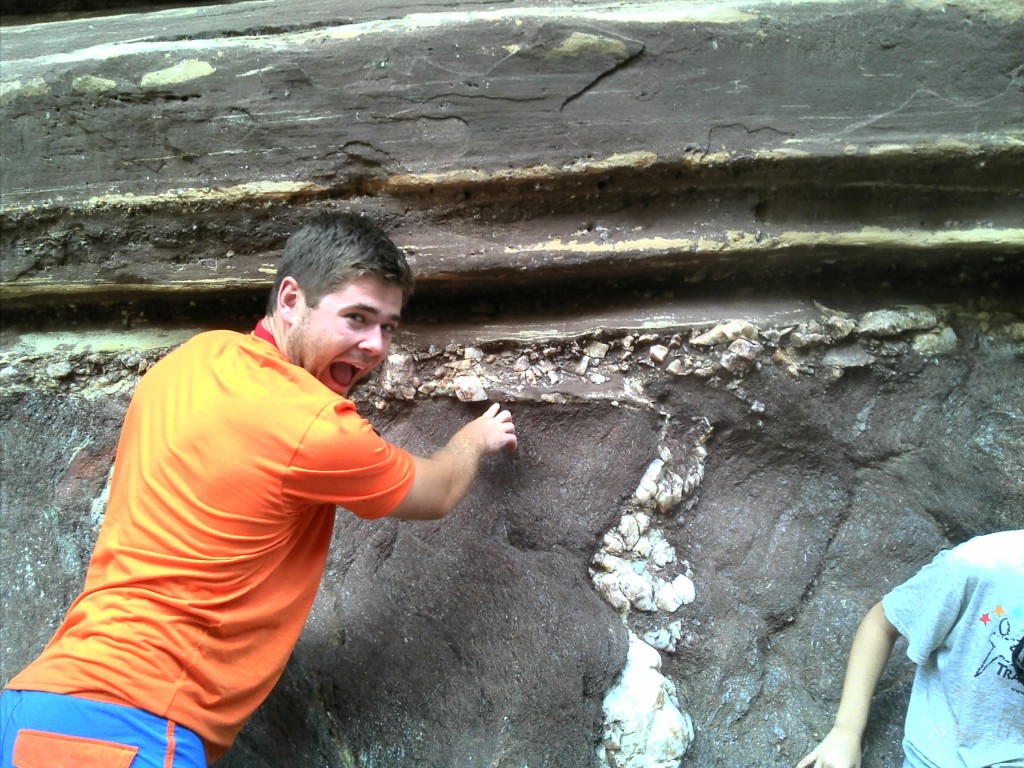
Robbie reacts strongly to the Great Unconformity (aka Powell Unconformity). This gap in the geologic record is between the lower Vishnu Schist, Precambrian in age and the upper Cambrian Tapeats Sandstone. About 1 billion years is missing at the boundary where Robbie points. Think also about the burial and exhumation stages that must occur to form this, it is quite profound.

Anasazi petroglyphs – this site is dated to AD 1000-1300 and perhaps was abandoned when the Medievel Anasazi droughts descended on the region.

Anasazi ruins – perhaps this outlook spot was occupied by the higher-ups in the society with others practiced dryland farming the floodplain of the Colorado River below.

The group on the overlook point – farther up-valley another settlement is located within sight of this point.
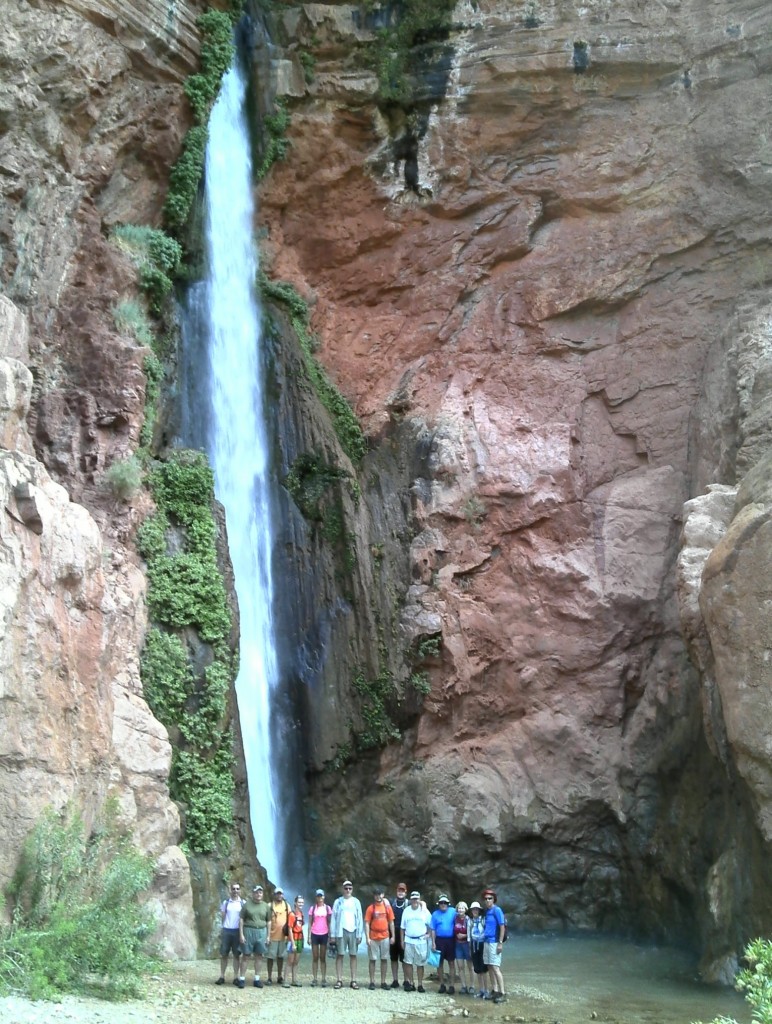
Deer Creek falls – one of the great falls in the Canyon. This stream was rerouted when a landslide dammed the Colorado and displaced the stream. The slide occurred shortly after the damming of the Colorado River by lava flows downstream. This new lake then saturated the Bright Angel Shale, which formed the slip surface of the massive landslide.

The team scopes out lava falls a class ten rapids. Most rapids exist where side canyons bring in large boulders in debris flows that accumulate at the confluence of the tributaries and the Colorado.

A side canyon that experienced a debris flow a few weeks before our trip. In the distance is the Colorado River – it is easy to see how these rapids are evolving as flash flooding and debris flows swept boulders and debris to the river. The tributary was dry the day of our visit.
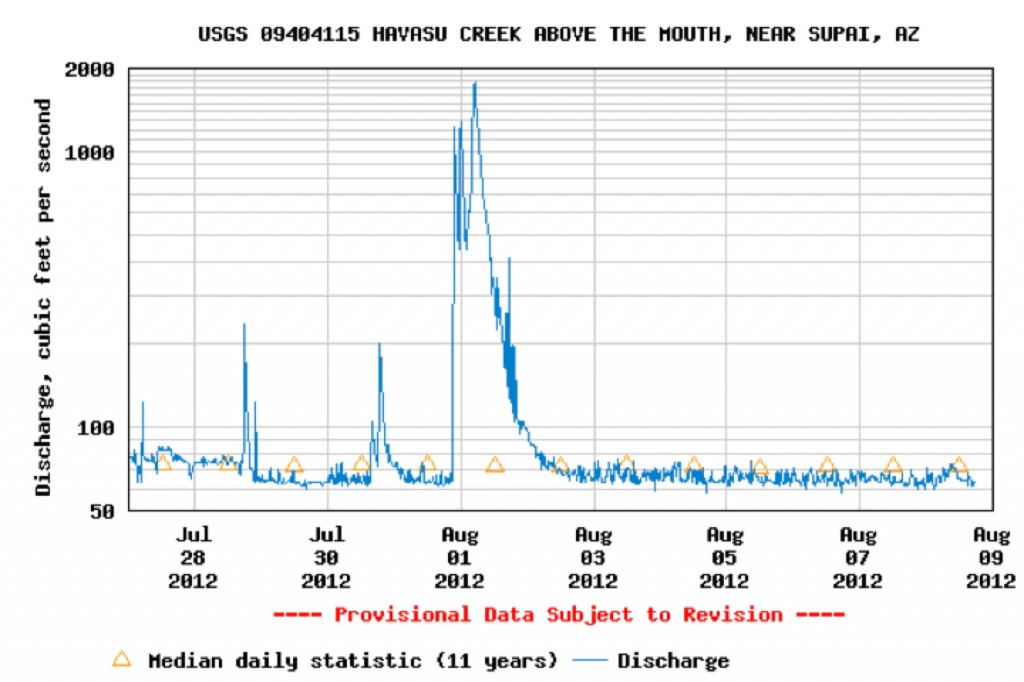
During our stay in the Canyon there was a massive storm event in the Havasu basin on 1 August. Above is the hydrograph showing the flash flood. We were unable to visit the Havisu Creek the next day because of the high flow. Below one can see the sediment and debris rich water in the Colorado River. Note also on the hydrograph that we had more than one rain event during our days in the Canyon. JP and Phil almost had to evacuate our camp as the Colorado was rising feet per hour.

The flash flood on 1 August flushed out an amazing amount of debris that included more logs and tree debris than seemed to be growing in the canyon. This beach and eddy in the distance is full of wood and debris.
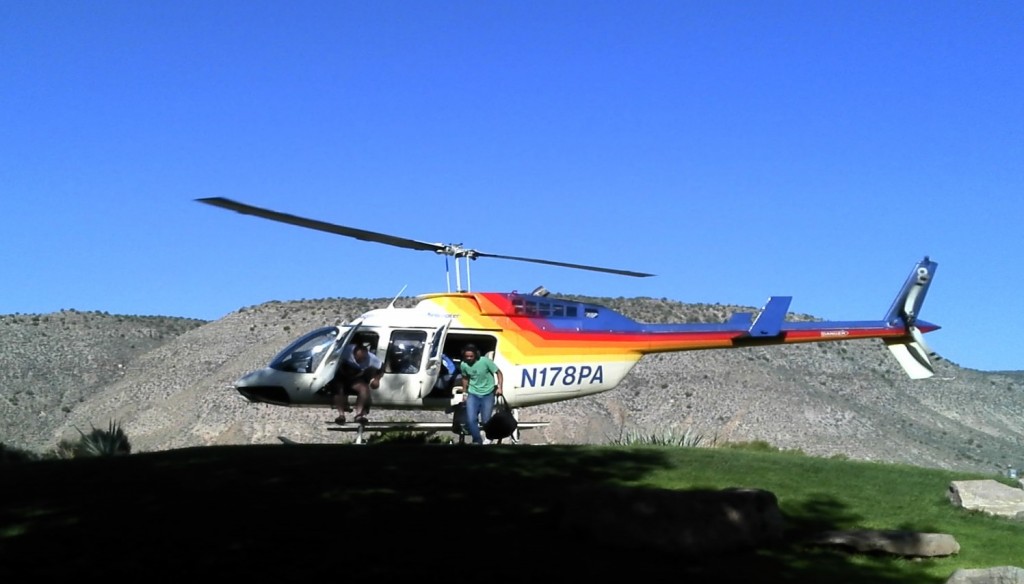
Flying out of the Grand Canyon to Bar Ten Ranch by helicopter. We then took a fixed wing flight out to the Flagstaff Airport.



Nice, Dr. Wiles! Helicopters, inside-out waterfalls, reverse exfoliation … you had a great time, it appears. Classic geology.
Wow…sounds like an incredible adventure. I like the North Canyon description. Great photos and verbiage.
You have a great job.
Greg,
Don and I want to thank you for all that you contributed to this trip.
It was not only fun to have you and Mimi to share the beauty and adventure with on this trip but your knowledge and your way of imparting that knowledge made our trip just that much better. We learned so much
from you and that learning served to enhance the beauty, the wonder, and magic of this incredible place. We are so grateful that our trip was shared with you.
With our deep appreciation,
Don and Janet
Kevin,I have been to the Grand Canyon and it was wonderful, but wow is it ever more betfaiuul and breathtaking from the eye of your lens!You were born to take these kinds of photographs Keep up your craft, you need to share your point of view of what is betfaiuul with the rest of the world xoxo,Miranda